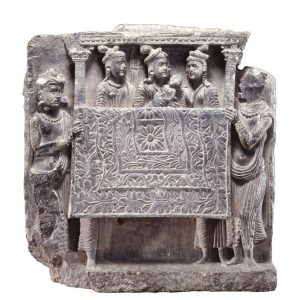
Nalbinding hat from Urumchi in the Tocharian or Yuezhi kingdom (ca. 1000 BC)
The Yamnaya become the Yuezhi
Around 3000 BC, in the Bronze Age, some of the Yamnaya people of Central Asia (also known as the Indo-Europeans) left their home between the Black Sea and the Caspian Sea and moved east, into what is now Kazakhstan, Kyrgystan, and western China. We call these people the Tocharians or the Yuezhi. They spoke a language related to Iranian, Hindi, and Scythian. And they had white skin, often with red hair and blue eyes.
The Yuezhi move south-west

Buddha’s return to Kapilavastu, Swat Valley, Pakistan (ca. 50 BC to 50 AD)
But in the 100s BC, the Xiongnu (possibly the ancestors of the Huns) defeated the Yuezhi. So a lot of the Yuezhi started moving south, to get out of the Xiongnu’s reach. Maybe they also wanted a bigger piece of the rapidly increasing Silk Road trade? First, the Yuezhi pushed the Scythians westward. Then the Yuezhi attacked the borders of the Parthian Empire, where they killed the young king Phraates in 129 BC. And seven years later, the Yuezhi killed Phraates’ uncle Artabanus.
The Kushan Empire

Buddha comes down from heaven. Butkara I, Swat Valley, Pakistan, 100s BC. Now in Swat Museum, Saidu Sharif.
Not long after that, the Yuezhi settled down in Bactria (modern Afghanistan), defeating the Indo-Greek kingdom there. Slowly they built their kingdom into the Kushan Empire. In the 100s AD, the Kushan Empire was south and east of the Sogdians, in what is now southern Afghanistan, Pakistan, and Kashmir in north-western India. They even conquered back some of their old land in western China. The Kushans got rich from Silk Road trade between India, Iran, and China, and from farming in what was at that time very well irrigated, sunny land. Thanks to their wealth, Kushan sculptors carved the great art of Gandhara. Most Kushan people were Buddhists, and Kushan traders and travellers brought Buddhism to China. They made alliances with the Han Dynasty emperors of China.
Collapse of the Kushan Empire
But in the early 200s AD, the rise of the Sassanian Dynasty in Iran led to the western part of the Kushan Empire falling under the control of the Sassanians. Then the northern part fell to the Hephthalites or White Huns, and the eastern part in India became part of the Guptan Empire. So that was the end of the Kushan Empire, though their descendants are still the Pashtun and the Kashmiris.